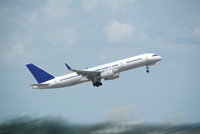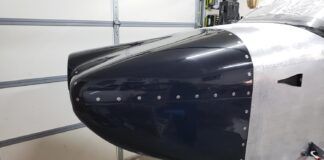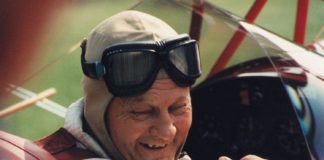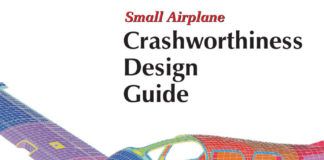In recent years, there has been increasing interest in the efficiency of all vehicles, including airplanes. Designers are seeking to make airplanes that perform better and burn less fuel.
In discussions of configuration concepts, it is common to see assertions that one particular approach to design is more efficient than the others. Unfortunately, these discussions often focus on one particular characteristic of the configuration and ignore others. Some examples of these are the idea that a canard is more efficient because the foreplane trims the airplane with an upward force as opposed to the downforce exerted by a conventional tail, the idea that a pusher is more efficient than a tractor because the pusher doesn’t blow in its own face, or the idea that a conventional airplane will be more efficient because the tail can trim powerful flaps, allowing it to have a higher wing loading. All of these assertions may be true, and all of the characteristics just cited do have favorable effects. What is not so obvious is that there may be other, offsetting negative characteristics that are part of the same package.
When we set out to design an airplane, or to evaluate different airplane concepts, it is likely that we will be comparing the usefulness of highly dissimilar airplane configurations. To better understand airplane efficiency, we need to step back from the details and look at what efficiency means in a broader context.
The mission of an airplane, in its simplest form, is to transport payload from one point to another. A reasonable metric of its transport efficiency is the fuel burn per pound-mile of payload, which is the amount of fuel the airplane consumes to transport each pound of payload one mile.
It is important to understand that the efficiency of the airplane as a useful transportation vehicle (transport efficiency) is tied to its ability to transport the weight of its payload, not to its ability to transport its total gross weight. The non-payload portion of an airplanes weight exists only to transport the payload. The only kinds of airplane for which this is not really true are racers and competition sailplanes, which have missions that require them only to transport themselves and a single pilot around a course. For all other types, the user of the airplane derives no utility from transport of the airplane itself, only from the transport of the payload. The crew and fuel are critical to this task, and they compose part of the useful load of the airplane. Accordingly, the portion of the gross weight that is useful to the user of the machine includes crew, fuel and payload.

New-technology powerplants make airliners like the Boeing 757 surprisingly efficient.
Components of Efficiency
Several aspects of the airplane contribute to its efficiency. The efficiency of the complete airplane in operation is the result of the combined effect of all of these components.
Propulsion: The propulsion system is the part of the airplane that actually burns the fuel and converts it into thrust. The amount of fuel consumed per pound of thrust is a significant determinant of the transport efficiency of the airplane. If the airplane is a jet, then the specific fuel consumption of the engine or engines (expressed in pounds of fuel per pound of thrust per hour) is the primary consideration.
For propeller-driven airplanes, there are two players, the engine and the propeller. The specific fuel consumption of the engine (usually expressed in pounds of fuel per horsepower per hour) and the efficiency of the propeller both affect the overall fuel burn.
Improvements in propulsion-system performance can have a large effect on the efficiency of airplanes. For example, a Boeing 757 burns about half the fuel per passenger-mile as the similar size Boeing 707. More than half of this improvement comes from the far better specific fuel consumption of the high-bypass engines powering the 757, as compared to the early generation turbojets on the 707.
In the light-airplane world, the designers ability to affect the performance of the propulsion system is limited primarily to making the right choice of engine and propeller.
Aerodynamics: The drag of the airplane in cruising flight determines how much thrust or power is needed to drive it through the air. The lower the drag, the lower the power requirement, and the lower the fuel burn. Accordingly, a designer seeking to maximize the efficiency of the airplane must seek to minimize cruise drag. For a constant weight, the most efficient airplane is the one with the highest cruise lift-to-drag ratio (L/D).
The aerodynamic configuration of the airplane has a large effect on its drag. Factors such as the wingspan, wetted area, smoothness of the skin, airfoil and many others all combine to determine how much drag the airplane will have. If all airplanes weighed the same, then L/D at cruise would be all that mattered, and the efficient airplane would look like an aerodynamicists dream.
Weight: The second factor affecting drag, and hence fuel burn, is weight. The aerodynamic configuration of the airplane determines the L/D. The actual drag is determined by the combination of L/D and the total amount of lift the airplane must generate to stay aloft. In 1-G level flight, this lift is equal to the weight of the airplane. For a given L/D, drag varies linearly with weight. Making the airplane lighter reduces drag, and making it heavier increases drag.
It is this combination of aerodynamics and weight that makes the task of creating an efficient airplane more complicated than it might initially appear. Some design features that increase L/D also increase weight, and some features that reduce weight also reduce L/D.
For example, increasing the wingspan, and hence aspect ratio of the wing will increase L/D. It also makes the wing structure heavier, increasing gross weight. If the L/D increases by a higher percentage than the gross weight, the span increase will reduce fuel burn. If weight rises by a greater percentage than L/D, then fuel burn will increase. This phenomenon is why powered airplanes have significantly lower aspect ratios than sailplanes. A sailplane is not powered, burns no fuel, and benefits from a pure L/D increase regardless of weight. A powered plane is ruled by the tradeoff between aerodynamics and weight.
An opposite example is the use of external bracing such as struts to save wing weight. The struts add parasite drag, but they reduce weight. Once again, the gain or loss depends on which effect happens first.
Transport Efficiency
As we noted earlier, the useful efficiency of an airplane is based on how much fuel it burns per pound of payload. To properly evaluate this, we need to evaluate the overall efficiency of an airplane as a useful load-transportation system. Accordingly, we now consider the case of a mission with a fixed payload. The question at hand is how to evaluate the efficiency of the airplane at transporting that amount of weight.
The fuel burn of an airplane flying at a given speed is directly proportional to the drag of the airplane. Thus, it initially appears reasonable to look to the cruise L/D of the airplane as a measure of its efficiency.
From a payload-transport-efficiency point of view, the L/D of the airplane is not the whole story. The L/D would be a valid metric of transport efficiency if all other factors were equal for competing configurations, but this is not the case. The structural weight and useful load fraction of the machine also play a major role.
The drag of the airplane is the gross weight of the airplane divided by the L/D.
D = W/(L/D)
In order to determine the transport efficiency of the airplane carrying useful load, we one must consider not lift-to-drag ratio, but useful-load-to-drag ratio:
First, note that the gross weight of the airplane can be expressed as:
WG = Wu (WG/Wu)
where
WG = airplane gross weight
Wu = useful load weight
The drag of the airplane can thus be expressed as:
D = Wu (WG/Wu)/(L/D)
Further manipulation shows that:
D = Wu {1/[(Wu/WG) (L/D)]}
or
Wu /D = (WP/WG) (L/D)
where
WP = payload weight
What the preceding mathematical exercise shows us is that the drag of an airplane carrying a specified useful load is affected equally by the aerodynamic efficiency of the airplane as determined by L/D and the useful load fraction of the airplane (Wu/WG). The most efficient airplane is found when the product of these two quantities, (Wu/WG) (L/D), which is the ratio of payload weight to drag, is maximized, thus minimizing the drag per unit useful load. What this analysis shows is that the designer has two major factors to work with. The first, and most obvious, is the aerodynamic performance as defined by L/D. The second is the structural efficiency of the airplane, as defined by the payload fraction or useful load fraction. A properly optimized concept will take advantage of both.
The quantity (WP/WG) (L/D) is particularly useful as a comparative figure of merit to evaluate dissimilar configurations intended for the same mission. It is applicable when the majority of the mission is performed in steady-state 1-G flight.
Barnaby Wainfan is a principal aerodynamics engineer for Northrop Grummans Advanced Design organization. A private pilot with single engine and glider ratings, Barnaby has been involved in the design of unconventional airplanes including canards, joined wings, flying wings and some too strange to fall into any known category.













